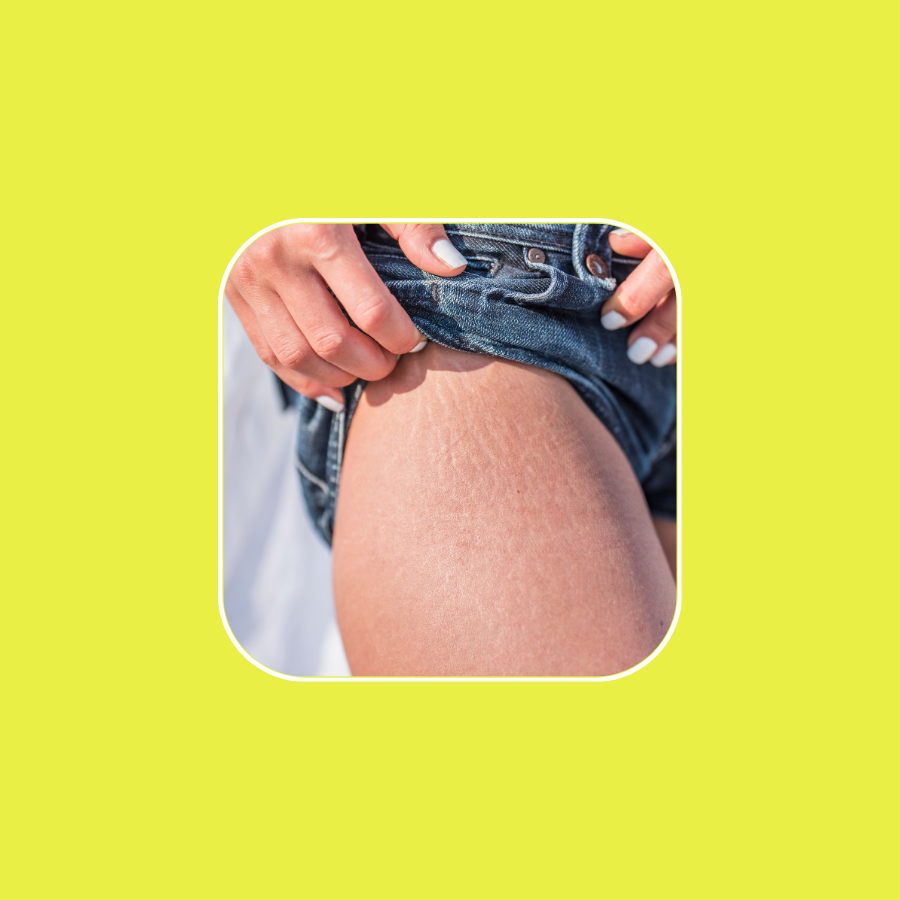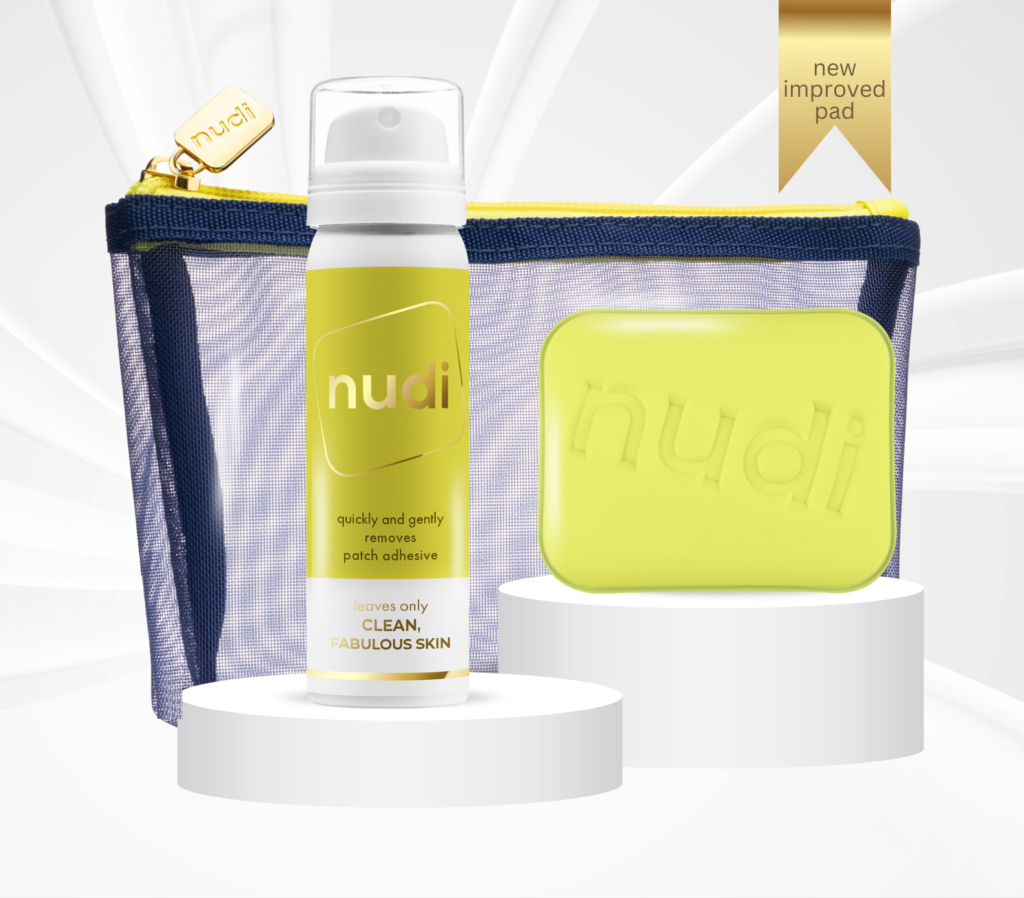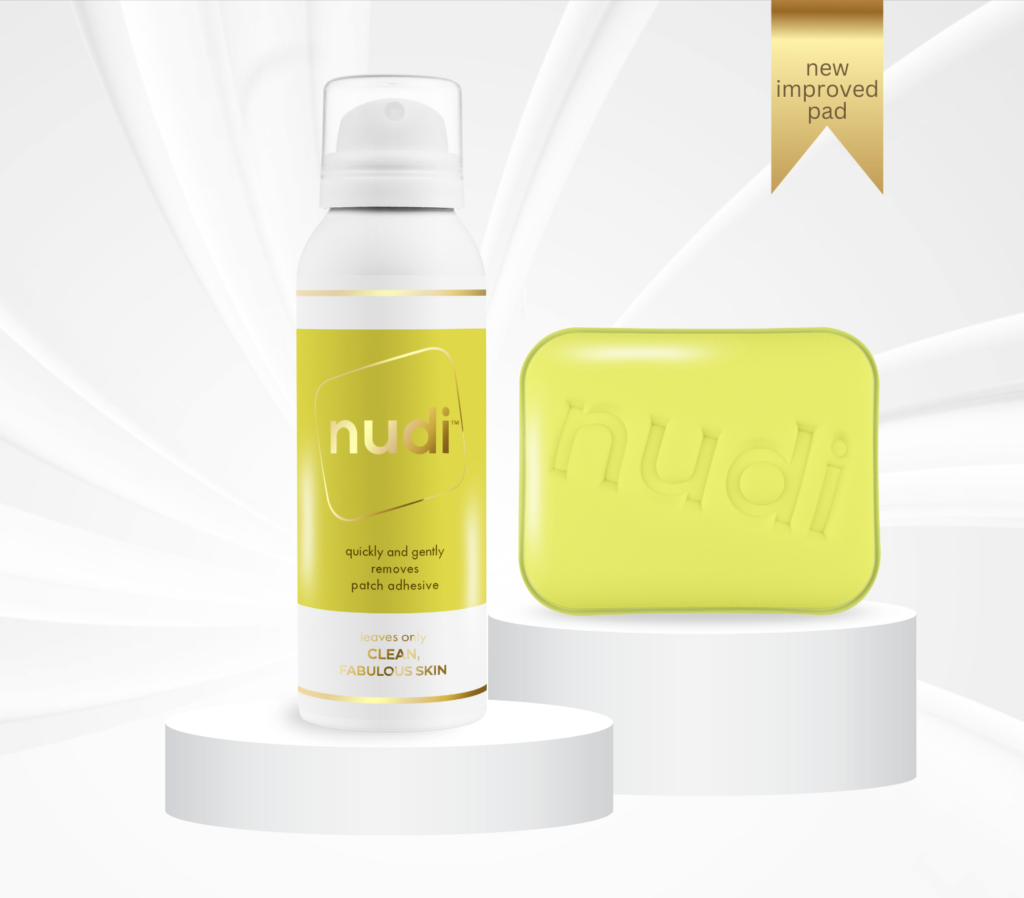
How to Prevent and Soothe Itchy Skin from HRT Patches
Introduction
Hormone Replacement Therapy (HRT) is a popular treatment for many of the challenges that come with menopause, like hot flushes, mood swings, night sweats, and vaginal dryness. For many people, using HRT patches is a convenient and effective way to manage these symptoms. The patches slowly release hormones through the skin, offering a steady, consistent dose.
However, as helpful as HRT patches can be, they can sometimes cause skin irritation. Itchy, red, or inflamed skin around the patch site can be a common concern, and while it’s generally harmless, it can still be uncomfortable. But don’t worry—there are ways to prevent and soothe this irritation! In this blog, we’ll share some tips for keeping your skin happy and comfortable while using HRT patches. Plus, we’ll introduce Nudi Spray™, a skin-friendly solution that helps remove adhesive residue without irritating your skin.
Why Do HRT Patches Cause Itching?
The Science Behind HRT Patches and Skin Reactions
HRT patches work by delivering hormones like oestrogen or progesterone through the skin directly into the bloodstream. This method offers a steady release of hormones, helping to ease menopause symptoms. The patches are designed to stick securely, allowing the medication to be absorbed properly over several days.
But here’s where things can get tricky: the adhesive used to keep the patch in place. While the adhesive is essential for ensuring proper absorption, it can sometimes irritate sensitive skin, causing discomfort like itching, redness, or even mild rashes.
Most of the time, this irritation is temporary and can be managed with a few simple adjustments. Still, it’s important to understand what’s happening so you can take steps to prevent it from getting worse.
Common Causes of Skin Irritation
There are a few reasons why HRT patches might cause skin irritation:
- Adhesive Sensitivity: The most common culprit is the adhesive itself. Some people are naturally sensitive to the sticky material, which can lead to itching or redness.
- Friction and Movement: If the patch is placed on an area that moves frequently, like your waist or armpits, the constant friction can cause irritation. The rubbing action can make your skin sore and itchy.
- Moisture Buildup: Sweat or moisture trapped under the patch can lead to skin irritation. If the patch is worn during exercise or in hot weather, moisture can get trapped between your skin and the patch, which may cause discomfort.
- Improper Placement: Placing the patch on areas with more sensitive skin or where clothing rubs against it frequently can cause irritation. It’s important to pick areas that are less prone to friction or sweat.
Now that we know what might be causing the irritation, let’s talk about how to prevent it from happening!
Best Practices to Prevent Itching
Choosing the Right Application Site
Choosing the right place to apply your HRT patch is key to avoiding irritation. Some areas of your body are more prone to sensitivity, so it’s a good idea to rotate patch locations. Consider places like your upper thigh, lower abdomen, or the outer upper arm—areas with less movement and less friction.
Also, be sure to rotate the spots where you place your patches. This gives your skin a break and reduces the chances of irritation in one spot. For example, try applying the patch to one side of your body for a few days, then switch to the other side the next time.
Prepping Your Skin Before Applying the Patch
Before you stick your patch on, take a moment to prep the area. Start by washing the skin with mild soap and lukewarm water. Avoid hot water, as it can dry out your skin and make it more sensitive. Pat the area dry with a towel before applying the patch.
It’s important not to apply lotions, oils, or creams right before applying your patch. These can interfere with how well the adhesive sticks and might make the patch less effective.
If you have particularly sensitive skin, you might want to use a skin barrier film. These films act as a protective layer between the adhesive and your skin, helping to reduce irritation while still allowing the hormones to be absorbed.
Using a Skin Barrier if Necessary
If you’re worried about irritation or have had issues with adhesives in the past, using a skin barrier film could be a great option. These films form a gentle layer between your skin and the patch, making the adhesive less likely to cause redness or itching. There are also hypoallergenic patches that use gentler adhesives—if you know your skin is sensitive, it may be worth trying these alternatives.
How to Soothe Itchy or Irritated Skin
Removing the Patch Gently with Nudi Spray™
If your patch has caused irritation, the first thing you should do is remove it gently. Ripping it off quickly can make things worse. Instead, use Nudi Spray™, a specially formulated adhesive remover that makes taking off the patch easy and painless.
Nudi Spray™ works by gently breaking down the adhesive, allowing the patch to be removed without tugging or scrubbing. This helps prevent further irritation. Plus, Nudi Spray™ contains Vitamin E, which helps soothe and protect your skin after patch removal.
Vitamin E’s Role in Soothing and Protecting the Skin
Vitamin E is a powerful antioxidant that helps calm and heal irritated skin. It’s well-known for its ability to reduce redness and promote skin repair. After removing the patch, try applying a product with Vitamin E to the affected area. It will help moisturise the skin, reduce inflammation, and protect it from further irritation.
Vitamin E is especially helpful for anyone with dry or inflamed skin. It locks in moisture and can make a big difference in how quickly your skin recovers.
Post-Patch Skincare Routine
After you’ve removed the patch, it’s important to take care of your skin. Gently apply a fragrance-free moisturiser to calm any irritation. Avoid harsh soaps, scrubs, or exfoliating products, as these can further aggravate your skin.
Look for skincare products that are specifically designed for sensitive skin, especially those that are hypoallergenic and free from alcohol or fragrances. These will help keep your skin hydrated and reduce any irritation caused by the patch.
When to Seek Medical Advice
While most irritation from HRT patches is mild and temporary, there are times when you should seek medical advice. If you notice that your skin is becoming more red, swollen, or blistered, or if you experience severe itching, it could be a sign of an allergic reaction.
If the irritation doesn’t improve or gets worse over time, it’s always a good idea to consult with your doctor. They may recommend switching to a different type of patch, using a topical cream to calm the irritation, or exploring other options for hormone therapy.
In rare cases, if you experience difficulty breathing, dizziness, or swelling in your face or throat, seek immediate medical attention—this could be a sign of a severe allergic reaction.
How Nudi Spray™ Helps with Comfort and Confidence
Using Nudi Spray™ as part of your routine can make a huge difference in how comfortable you feel when using HRT patches. It makes removing your patch easier and less painful, helping to avoid further irritation. The Vitamin E in the spray also nourishes and soothes the skin, providing relief from discomfort.
Customers who’ve used Nudi Spray™ report feeling much more comfortable with their patches. They love how quickly and gently it removes the adhesive without causing additional irritation. Plus, with regular use, you’ll find that your skin stays calm and irritation-free, making the whole HRT process much more manageable.
So To Round Up
Itching and irritation from HRT patches don’t have to be a constant struggle. By following simple steps like rotating patch sites, prepping your skin properly, and using skin-friendly products like Nudi Spray™, you can prevent and soothe discomfort. Don’t forget that taking care of your skin is an important part of the HRT journey.
If irritation persists or becomes more severe, always reach out to your healthcare provider. With the right care and products, you can continue your treatment comfortably and confidently.
FAQs
- Why do HRT patches make my skin itch? Itching can happen because of the adhesive used in the patch. Some people have sensitive skin, which can react to the sticky material.
- Can I apply lotion before putting on my HRT patch? It’s best to avoid applying lotions or oils right before putting on your patch. These can affect the adhesion and may cause irritation.
- How often should I change my patch placement to prevent irritation? Try rotating patch placement every time you change it. This helps prevent irritation by giving your skin a chance to recover.
- What’s the best way to remove a patch without irritating my skin? Use Nudi Spray™, a gentle adhesive remover, to break down the sticky material without tugging or scrubbing.
- Where can I buy Nudi Spray™ for easy patch removal? You can find Nudi Spray™ online or at select pharmacies. Check the official website or your local pharmacy for more information.
Our Products

Adhesive Remover Starter Kit
Designed to remove the most stubborn patch or tape glue from all skin types in a neat travel sized pack .
- Nudi Spray™ 50ml
- Easi Pad™
- Nudi™ Patch Bag
£15

Glue Free Forever!
Subscribe & Save
Enjoy our great value subscription direct to your door without giving glue another thought.
- Nudi Spray™ 100ml
- Easi Pad™
- Cancel anytime
£16

Top Up!
Designed to remove the most stubborn patch or tape glue from all skin types in our larger 100ml can.
- Best Seller
- Nudi Spray™ 100ml
- Easi Pad™
